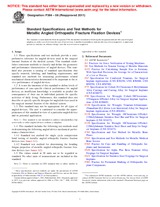Wir benötigen Ihre Einwilligung zur Verwendung der einzelnen Daten, damit Sie unter anderem Informationen zu Ihren Interessen einsehen können. Klicken Sie auf "OK", um Ihre Zustimmung zu erteilen.
ASTM F384-06(2011)
Standard Specifications and Test Methods for Metallic Angled Orthopedic Fracture Fixation Devices
Automatische name übersetzung:
Standard-Spezifikationen und Prüfverfahren für metallische Angled Orthopedic Fracture Fixation Devices
NORM herausgegeben am 1.6.2011
Informationen über die Norm:
Bezeichnung normen: ASTM F384-06(2011)
Anmerkung: UNGÜLTIG
Ausgabedatum normen: 1.6.2011
SKU: NS-55116
Zahl der Seiten: 11
Gewicht ca.: 33 g (0.07 Pfund)
Land: Amerikanische technische Norm
Kategorie: Technische Normen ASTM
Die Annotation des Normtextes ASTM F384-06(2011) :
Keywords:
angled devices, bend testing, blade plate, compression hip screw, fatigue test, orthopedic medical devices, surgical devices, surgical implants, Bend testing--surgical materials, Angled orthopaedic fracture fixation devices, Blade plates, Compression hip screw, Fracture fixation devices, Metallic surgical implant materials--specifications, Nail bones/plates, Orthopaedic medical devices (bone)--specifications, Orthopaedic medical devices (bone plates)
Ergänzende Informationen
| Significance and Use | ||||||||||||||||||||||||||||||||||||||||||||||
|
A2.5.1 The test method establishes a uniform cantilever bending fatigue test to characterize and compare the fatigue performance of different angled device designs. This test method may be used to determine an angled device's fatigue life at either a specific or over a range of maximum bending moment conditions. Additionally, this test method may be alternatively used to estimate an angled device's fatigue strength for a specified number of fatigue cycles. A2.5.2 The test method utilizes a simplified angled device cantilever bending load model that may not be exactly representative of the in-situ loading configuration. The user should note that the test results generated by this test method can not be used to directly predict the in-vivo performance of the angled device being tested. The data generated from this test method can be used to conduct relative comparisons of different angled device designs. A2.5.3 This test method may not be appropriate for all types of implant applications. The user is cautioned to consider the appropriateness of the method in view of the devices being tested and their potential application. A2.5.4 This test method assumes that the angled device is manufactured from a material that exhibits linear-elastic material behavior; therefore, this test method is not applicable for testing angled devices made from materials that exhibit nonlinear elastic behavior. A2.5.5 This test method is restricted to the testing of angled devices within the material's linear-elastic range; therefore, this test method is not applicable for testing angled devices under conditions that would approach or exceed the bending strength of the angled device being tested. |
||||||||||||||||||||||||||||||||||||||||||||||
| 1. Scope | ||||||||||||||||||||||||||||||||||||||||||||||
|
1.1 These specifications and test methods provide a comprehensive reference for angled devices used in the surgical internal fixation of the skeletal system. This standard establishes consistent methods to classify and define the geometric and performance characteristics of angled devices. This standard also presents a catalog of standard specifications that specify material, labeling, and handling requirements, and standard test methods for measuring performance related mechanical characteristics determined to be important to the in vivo performance of angled devices. 1.2 It is not the intention of this standard to define levels of performance of case-specific clinical performance for angled devices, as insufficient knowledge is available to predict the consequences of their use in individual patients for specific activities of daily living. Futhermore, this standard does not describe or specify specific designs for angled devices used in the surgical internal fixation of the skeletal system. 1.3 This standard may not be appropriate for all types of angled devices. The user is cautioned to consider the appropriateness of this standard in view of a particular angled device and its potential application. Note 1—This standard is not intended to address intramedullary hip screw nails or other angled devices without a sideplate. 1.4 This standard includes the following test methods used in determining the following angled device mechanical performance characteristics: 1.4.1 Standard test method for single cycle compression bend testing of metallic angled orthopedic fracture fixation devices (see Annex A1). 1.4.2 Standard test method for determining the bending fatigue properties of metallic angled orthopedic fracture fixation devices (see Annex A2). 1.5 The values stated in SI units are to be regarded as standard. No other units of measurement are included in this standard. Note 2—There is currently no ISO standard that is either similar to equivalent to this standard. |
||||||||||||||||||||||||||||||||||||||||||||||
| 2. Referenced Documents | ||||||||||||||||||||||||||||||||||||||||||||||
|
Empfehlungen:
Aktualisierung der technischen Normen
Wollen Sie sich sicher sein, dass Sie nur die gültigen technischen Normen verwenden?
Wir bieten Ihnen eine Lösung, die Ihnen eine Monatsübersicht über die Aktualität der von Ihnen angewandten Normen sicher stellt.
Brauchen Sie mehr Informationen? Sehen Sie sich diese Seite an.




 Cookies
Cookies
